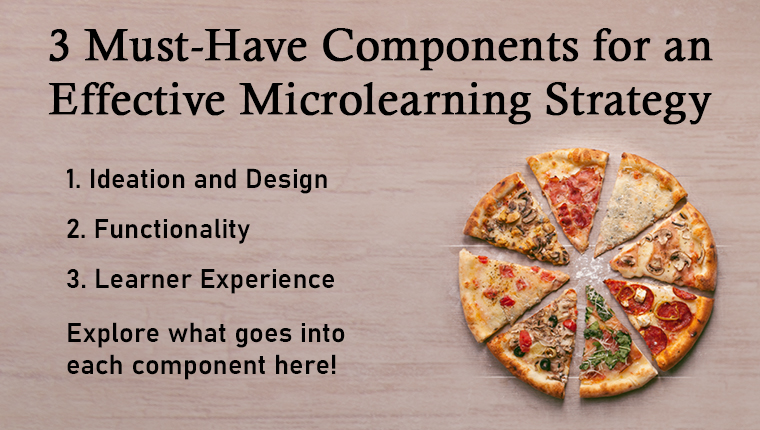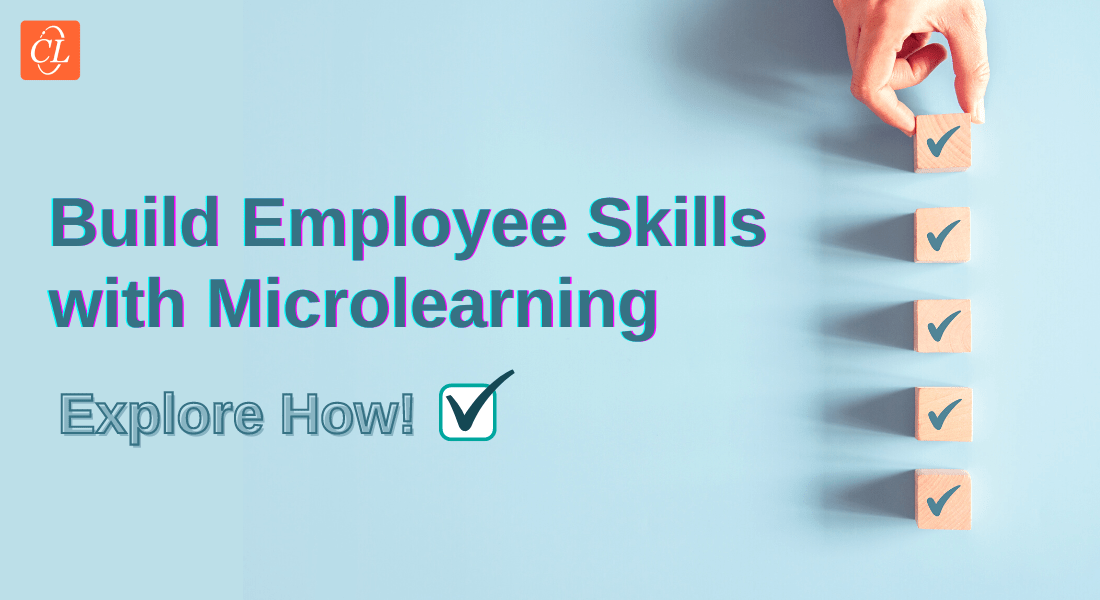A Microlearning Story: From Design to Learner Experience

L&D circles are abuzz with ‘Microlearning’. And don’t mistake it for being yet another trend that’s going to fade away with time! Microlearning is real, impactful, and shows no sign of phasing out anytime soon.
3 Aspects of a Successful Microlearning Strategy
1. Ideation & Design
- Plan for a curriculum of micro modules
- Focus on one learning objective per module
2. Functionality
- Enable anytime, anywhere learning
- Offer multiple formats for different functions
3. Learner Experience
- Encourage continuous learning
- Enable spaced learning
According to an ATD research report, 40% of the surveyed organizations are currently using microlearning solutions for workforce training and 41% of remaining 60 are planning to use it within a year. The global microlearning market is growing at a CAGR of 15.2% since 2018 and is expected to reach $4.68 billion by 2027. Looking at these stats, it is not surprising that L&D professionals across the world are keen to implement microlearning solutions for their employee training programs.
→ Explore our one-stop guide on microlearning for effective workforce training.
What is the Reason Behind the Rising Success of Microlearning?
In the last decade, there has been a paradigm shift, both in the corporate learner profile and corporate modus operandi. The influx of new-gen corporate learners – millennials and Gen Z – into the workplace and increasing diversity has changed training requirements as well as learners’ expectations from training.
In today’s training, a lot of attention is given to engagement, edutainment, flexibility, and round-the-clock accessibility. Moreover, we have a more ‘away from the desk’ and remote workforce than ever before. All these changes have encouraged learning professionals to look for a solution that can:
- Hook learners’ attention immediately
- Engage them in training, leaving no room for distractions
- Provide focused and precise information that can be retained easily
- Make information accessible at the moment of need
Microlearning with its ‘bite-sized’ modules is the best solution for all these training requirements. In this blog, we’ll help you strategize for a successful microlearning plan, in terms of design, functionality, and learner experience.
What Goes into Creating an Effective Microlearning Strategy?
1. Microlearning Ideation and Design
What makes a microlearning solution different from other eLearning solutions or courses? That’s easy! It’s shorter and is focused on only one topic instead of dealing with a range of them. These two differences are the key to design an effective microlearning solution. Here are a few ideas to get started with microlearning.
Plan for a Curriculum of Micro Modules
Neuroscientific research says that the average attention span of adults is about 20 minutes. Beyond that, the brain needs a break; otherwise it tends to get distracted. So, the training must be designed to make the most of these 20 minutes. That is why most microlearning modules are 10-15 minutes long. In case the training covers a broad range of topics, it is always better to plan for a curriculum with multiple microlearning courses, each covering a single topic, instead of going for one lengthy eLearning course.
Focus on One Learning Objective per Module
This is the age of instant everything, instant noodles, instant food delivery, instant cash transactions, and of course, instant information.
Put yourself in your employee’s shoes for a minute. Imagine that in the middle of the workday, he needs some information urgently to resolve a crisis. He accesses an eLearning course for that particular piece of information. But he has to go through a lot of stuff in the course before locating the precious information he needs so badly.
And it’s no better if he has to refer to a manual or paper-based resource. This is where microlearning courses are so useful. As each is designed to address only one learning objective, you can avoid the hassle and the wasted time and get in-depth information about a specific topic.
2. Microlearning Functionality
How can you ensure your microlearning strategy is a success? Well, you can provide two things that your learners need – round-the-clock accessibility and flexibility.
Enable Mobile Learning for Anytime, Anywhere Training
Modern learners are not very happy with the idea of sitting behind a desk in the office and taking lengthy training courses. And honestly, often they don’t have the time or the facility (in case of desk-less and remote workers) to do that in the middle of the workday. They would want learning to happen while commuting to and from the workplace, when stuck in traffic, in the cafeteria during lunch break, in the airport while traveling, or even when they are out in the field.
A combination of microlearning and mobile learning can be used to make learning instantly accessible to learners anytime, anywhere.
Offer Multiple Microlearning Formats for Different Functions
The mantra ‘Form follows function’ can guide you toward a successful microlearning solution. But what does it mean? Well, it means that from the range of microlearning formats available (videos, flashcards, audio podcasts, infographics, animations, quizzes, and so on), you need to choose the format based on the function, i.e., the learning objective of the course. You should never first choose the format and try to fit in content in it.
For instance, if the learning objective is to help learners understand a concept or a process, you can use videos, animation, even podcasts. If the learning objective is skill development, simulations, quizzes, or games can be used.
Another benefit of having multiple microlearning formats is that you can design different assets for the same training content. This gives learners the flexibility to choose how they want to learn.
3. Microlearning Experience
It’s all about experiential learning now. From learning platforms like LXP to learning models like AGES, there is a lot of focus on building an experiential learning journey for the learner. Concepts like edutainment too are gaining momentum. So, how can you enhance your microlearning experience?
Encourage Continuous Learning
Learning is (and should be) a continuous process that doesn’t grind to a halt just because the formal training program is over. Since microlearning nuggets focus on only one learning objective, they can used as standalone modules outside a formal training curriculum.
They can be posted in discussion boards and online forums, and also be easily shared among learners and instructors in chat boxes and other messaging apps. This way, microlearning can be used to make continual learning a reality, while also encouraging social learning and collaborations.
Enable Spaced Learning
The entire idea of microlearning is based on the simple idea that learning is more effective when it is given in small doses, in spaced intervals. This will result in better retention and recall of information and help beat the forgetting curve. Many organizations are finding spaced microlearning to be a real hit with their employees, especially the millennial workers.
Summing it Up!
To summarize, microlearning is a highly effective training strategy that can greatly boost your employees’ performance. It is especially relevant in the present time with all the training disruptions due to COVID-19.
It inherently facilitates learning by being shorter in duration. Even lengthy eLearning courses can be broken down into multiple microlearning modules. Also, multiple microlearning formats enable training reinforcement without being repetitive. If you want to know more about microlearning, here’s a free eBook that you can download right away.
Editor’s note: This post was originally published in June 2020 and has been updated for comprehensiveness.




![The What and Why of Microlearning for Your Learning Strategy [Infographic]](https://blog.commlabindia.com/hubfs/Imported_Blog_Media/microlearning-what-why-infographic-main.jpg)

